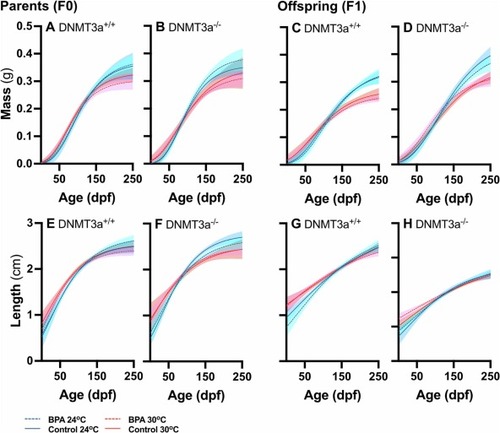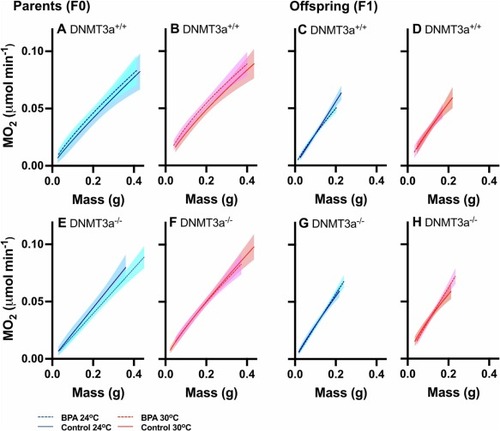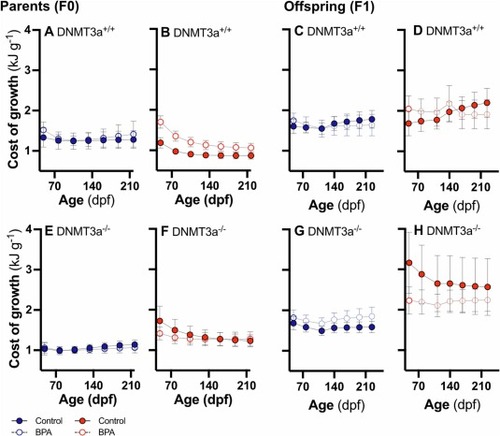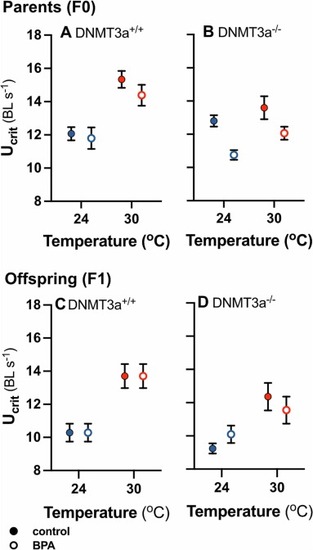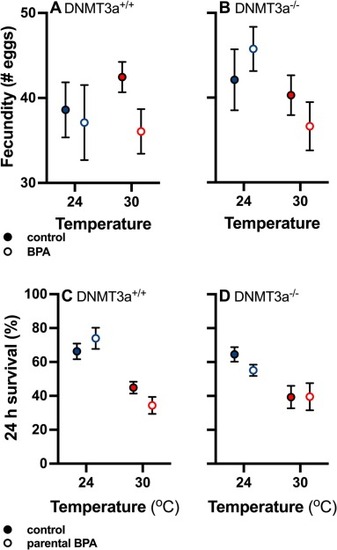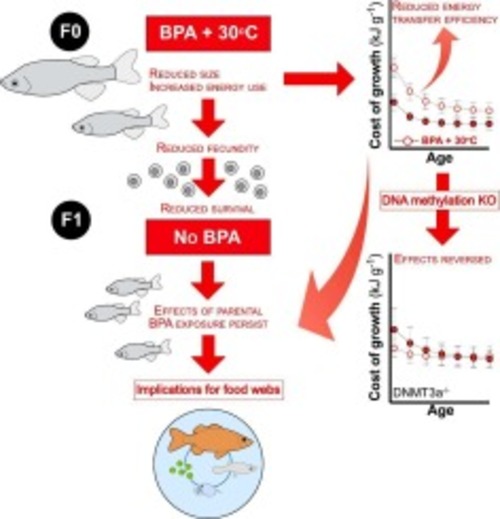- Title
-
Warming and pollution interact to alter energy transfer efficiency, performance and fitness across generations in zebrafish (Danio rerio)
- Authors
- Seebacher, F., Bamford, S.M.
- Source
- Full text @ Sci. Total Environ.
|
Growth of parents (F0) and offspring (F1). Change in parents mass (A, B) and length (E, F), and offspring mass (C, D) and length (G, H) during development was determined by interactions between genotypes (A, C, D, E no-template control [DNMT3+/+]; B, D, F, G CRISPR knock-out [DNMT3a−/−]), (parental) BPA exposure (BPA = broken lines, control = solid lines), temperature (24 °C = blue lines; 30 °C = red lines), and age (days post-fertilisation [dpf]). The lines represent Gompertz models fitted to data from individual fish, and shading around lines (turquoise and pink = BPA; blue and orange = control) shows 95 % confidence intervals. Sample sizes were n = 10–12 fish per treatment, and raw data are shown in Supplementary material Fig. S1 and S2. |
|
Metabolic rates of parents (F0) and offspring (F1). Parent metabolic rates (A, B, E, F) were influenced by genotype (A, B DNMT3a+/+; E, F DNMT3a−/−) on 49, 77, and 105 days post fertilisation (dpf), but not at 189 dpf. Genotype interacted with BPA exposure (control = solid line; BPA exposure = broken line), and metabolic rates changed with temperature (A, E blue symbols = 24 °C; B, F red symbols = 30 °C). In particular, the BPA-induced increase in metabolic rate at 30 °C was not apparent in the DNMT3a−/− genotype. Offspring (F1) metabolic rates were influenced by a genotype (C, D DNMT3a+/+; G, H DNMT3a−/−) × temperature (C, G blue symbols = 24 °C; D, H red symbols = 30 °C) interaction at 49 days post-fertilisation (dpf), and by temperature at 77 dpf. Genotype had a main effect at 105 dpf. Parental BPA exposure = broken line, parental control = solid line. Means ±95 % CI are shown (24 °C: turquoise shading = 95 % CI for BPA treatment, light blue = control; 30 °C: pink shading = 95 % CI BPA treatment, orange = control), and n = 10–12 fish per treatment. |
|
Estimated cost of growth (Em). We used growth and metabolic relationships to estimate the amount of food-derived energy necessary to produce a unit of new biomass (cost of growth, kJ g−1) at the time points when we measured individual size. In parents, Em was influenced significantly by a three-way interaction between genotype (A, B DNMT3a+/+, E, F DNMT3a−/−), BPA exposure (BPA exposure = open circles, control = filled circles), and temperature (blue = 24 °C, red = 30 °C); notably, BPA increased Em at 30 °C. Offspring Em was affected significantly by two three way interactions between genotype (C, D DNMT3a+/+; G, H DNMT3a−/−) BPA exposure, and temperature, and genotype, age, and temperature (symbols as for parents). Means ± s.e. are shown and n = 10–12 fish per treatment. |
|
Swimming performance of parents (F0) and offspring (F1). Swimming performance (Ucrit) of parents (A, B) was influenced by interactions between genotype (A DNMT3a+/+; B DNMT3a−/−) and temperature (blue symbols = 24 °C; red symbols = 30 °C), and genotype and BPA exposure (control = filled circles; BPA exposure = open circles). BPA exposure decreased swimming performance and this effect was more pronounced in DNMT3a−/− fish, and Ucrit increased with increasing temperature but this effect was more pronounced in DNMT3a+/+ fish. Offspring (F1) swimming performance (C, D) was influenced by main effects of genotype (C DNMT3a+/+; D DNMT3a−/−) and temperature. Means ± s.e. are shown and n = 10–12 fish per treatment. |
|
Reproductive success. Estimated fecundity (A, B, number of eggs per tank) and 24 h survivorships of offspring eggs (C, D, percent) of DNMT3a+/+ (A, C) and DNMT3a−/− (B, D) genotypes exposed to BPA (filled circles = control; open circles = BPA exposure) at different temperatures (blue symbols = 24 °C, red symbols = 30 °C). Fecundity was influenced by an interaction between BPA exposure and treatment, decreasing fecundity at 30 °C, and survival was determined by a three-way interaction between genotype × temperature × BPA exposure. Note that parents were exposed directly to BPA but offspring were reared in clean water. Means ± s.e. are shown from 9 to 17 tanks per treatment. |
|
|

